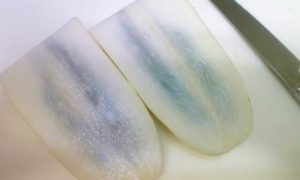Do you ever feel bitter while eating radishes? (not spicy)
This is a phenomenon that tends to occur when the soil is hot and humid and lacks boron.
In addition, there are cases where the cut cross section has something like blue-black streaks called bruises.

bruise
In addition, hot and humid conditions and boron deficiency tend to occur from summer to autumn.
On the other hand, the season for daikon radish is from autumn to winter, and daikon radish harvested during this period becomes much sweeter in the cold weather.
Insufficient boron results in poor root growth, poor skin gloss, poor shape, cracks in the epidermis, low-moisture soot inside, and brown core.
How to distinguish delicious radishes
(1) When a leaf has been cut off, check the cross section to make sure there are no cavities in the cross section of the leaf. (If there are cavities, there is a high possibility that the radish contains soot due to a lack of boron.)
(2) Pores on the root of the hair are shallow and few, and they line up straight. (Because if you lack boron, your skin will not be glossy.)
(3) The leaves are fresh and spread radially.
From here on it's subjective.
In the end, the conclusion is to buy a beautiful radish.
However, there is also a pattern that the daikon radish that I bought because I thought it was beautiful and okay was bitter. (Besides, you can only taste it after cooking.)
If you knew it was bitter before you ate it
① Turn the skin thick
② Thoroughly preboil
③ Expose to water
And so on.
